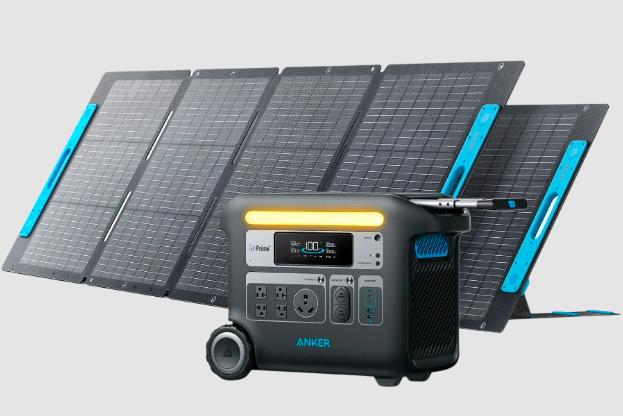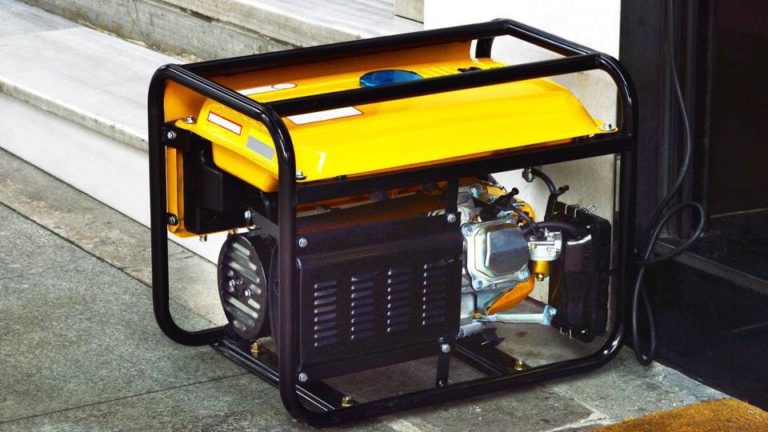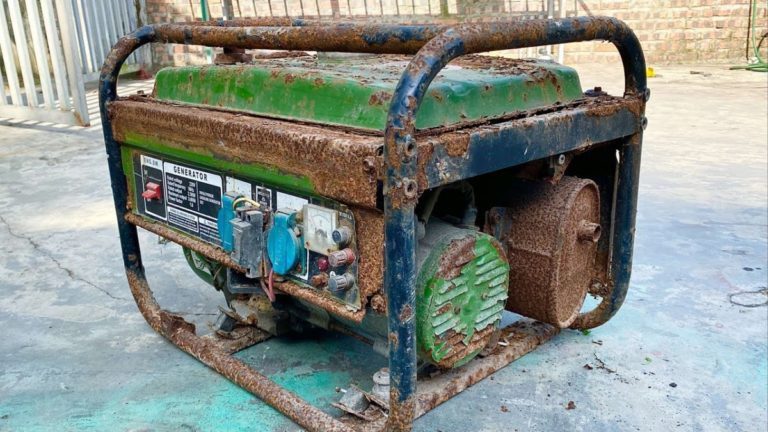When it comes to living off the grid, having a reliable source of electrical power is important.
One of the most important components of any off-grid power system is the combination of a generator and battery bank.
Properly sizing these components is essential to ensure that your system meets all of your energy needs without breaking the bank or causing damage to sensitive electronics.
We will provide actionable information on how to properly size your generator and battery bank for an off-grid power setup.
We’ll cover key factors such as load calculation, voltage requirements, and reserve capacity needs, so you can make informed decisions and avoid common mistakes.
Whether you’re a seasoned DIYer or just starting out with off-grid living, this guide is designed to provide the information you need to get your power system up and running smoothly.
Determine your average daily energy usage
To determine the right size generator and battery bank, you need to know how much energy you use on average per day. This includes powering appliances like lights, refrigerator, heater, and water pump.
This includes powering appliances like lights, refrigerator, heater, and water pump.
First, make a list of all the appliances you want to power and their corresponding wattage requirements.
For example, a standard refrigerator consumes around 150-200 watts, while a heater can use up to 1500 watts or more.
Next, calculate your daily energy usage by multiplying the wattage of each appliance by the number of hours you use it per day.
For instance, if you use your refrigerator for 8 hours a day and it consumes 150 watts, you would need 1200 watt-hours (Wh) of energy from your generator and battery bank.
It is also important to consider the start-up watts required by each appliance, which is usually higher than the running watts.
For instance, a water pump may require 1500 watts to start but only uses 500 watts to run.
You should consider the efficiency of your appliances, as more efficient appliances will use less energy to perform the same task.
By accurately determining your energy usage, you can select the appropriate size generator and battery bank to meet your needs and ensure a reliable and efficient off-grid solar power system.
Calculate your peak power usage
Peak power usage refers to the maximum amount of power you need to use at any given time. This could be during starting loads like a well pump or a backup heater.
Peak power usage refers to the maximum amount of power you need to use at any given time.
This could be during starting loads like a well pump or a backup heater, which require a surge of energy to get started.
These peak power loads can put a strain on your electrical system, particularly if you have a smaller capacity solar panel system or a limited battery bank.
To accommodate these peak power loads, it’s important to consider the size and capacity of your solar panel system and battery bank when designing your off-grid electrical system.
This will ensure that you have enough power to meet your needs, while also avoiding any potential overloads or damages to your system.
In addition, it’s important to note that peak power usage can vary depending on the time of day and the season.
For example, during the winter months, you may need to use more power to heat your home, while during the summer months, you may need to use more power to cool your home.
By understanding your peak power usage and how it changes throughout the year, you can better plan and size your solar panel system and battery bank to meet your needs.
Consider the duration of use
Generators and battery banks are rated by how long they can supply power continuously. Decide how long you need the system to run each day.
When selecting a generator or battery bank for your off-grid energy system, it’s important to consider how long you need the system to run each day.
The rating of a generator or battery bank is based on how long it can supply power continuously.
This is typically measured in hours, and it’s important to choose a system that can supply power for the amount of time you need it to each day.
For example, if you need to run your lights and appliances for 8 hours a day, you’ll need a generator or battery bank that is rated to supply power for at least 8 hours.
It’s important to note that the amount of time you need the system to run each day will affect the size and cost of the generator or battery bank you need.
It’s important to consider any additional loads you may need to power, such as a well pump or an electric vehicle, when determining the size of your generator or battery bank.
By carefully considering your power needs, you can choose the right generator or battery bank for your off-grid energy system.
Choose the right fuel type
Generators come in various fuel types, including gasoline, propane, and diesel. Choose a fuel type that’s readily available and affordable in your area.
When selecting a generator, fuel type is a important consideration.
Generators are available in three main fuel types: gasoline, propane, and diesel.
Each fuel type has its own set of advantages and disadvantages, and the best choice for you will depend on your specific needs and the availability of fuel in your area.
Gasoline-powered generators are the most common and widely available type.
They are easy to use and maintain, and can be purchased at most hardware stores.
However, gasoline generators produce emissions and can be noisy.
They are also more expensive to run than propane or diesel generators.
Propane-powered generators are a popular choice for those who live in rural areas or have limited access to gasoline.
Propane is a clean-burning fuel that produces fewer emissions than gasoline.
However, propane generators are typically more expensive and may require more maintenance than gasoline generators.
Diesel-powered generators are the most fuel-efficient and longest-lasting option.
They produce less noise and emissions than gasoline generators and are more cost-effective in the long run.
However, diesel generators are typically more expensive upfront and may require specialized maintenance.
Before making a decision, it’s essential to consider the availability of fuel in your area and the costs associated with each fuel type.
Gasoline may be readily available in urban areas, but propane or diesel may be more accessible in rural areas.
The cost of fuel can vary significantly depending on the type and location.
Choosing a fuel type that’s readily available and affordable in your area can ensure that your generator is reliable and cost-effective over the long term.
Select the right battery type
Lead-acid and lithium-ion are the two common types of batteries used in off-grid power systems. Lead-acid batteries are more affordable but have a shorter lifespan, while lithium-ion batteries are more expensive but have a longer lifespan.
Lead-acid batteries are a more affordable option, but they have a shorter lifespan compared to lithium-ion batteries.
Lead-acid batteries are traditionally flooded with acid, which requires regular maintenance and can be hazardous to the environment.
They have a lifespan of around 5-7 years, after which they need to be replaced.
On the other hand, lithium-ion batteries are more expensive but offer a longer lifespan of up to 15 years.
These batteries are more environmentally friendly, as they do not require acid and are made from recyclable materials.
Lithium-ion batteries have a higher energy density, which means they can store more energy per unit of weight, making them ideal for off-grid power systems that require a long-lasting energy source.
Determine the discharge rate
Discharge rate refers to the amount of power the battery bank can supply over a specific time. Choose a battery bank with a discharge rate that matches your daily energy usage.
When selecting a battery bank for your off-grid energy system, it’s important to consider the discharge rate of the batteries.
Discharge rate refers to the amount of power the battery bank can supply over a specific time.
In other words, it’s the rate at which the batteries can provide energy to your home or business.
To determine the appropriate discharge rate for your needs, you’ll need to first assess your daily energy usage.
This includes the power required to run your appliances, lighting, and other electrical devices.
Once you have a clear understanding of your energy usage, you can choose a battery bank with a discharge rate that matches your needs.
For example, if you have a small home with only a few appliances, you may only need a battery bank with a discharge rate of 100-200 watts.
However, if you have a larger home with multiple appliances and high power usage, you may need a battery bank with a discharge rate of 1000-2000 watts or more.
It’s also important to consider the depth of discharge (DOD) of the batteries, which refers to the amount of energy the batteries can supply before they need to be recharged.
A higher DOD means the batteries can supply more energy before needing to be recharged, but it also means the batteries may have a shorter lifespan.
By choosing a battery bank with a discharge rate that matches your daily energy usage, you can ensure that your off-grid energy system provides the power you need while also minimizing waste and extending the lifespan of your batteries.
Consider the charge controller
A charge controller is an essential component of your off-grid power system. It ensures the generator charges the battery bank safely and efficiently. Choose a charge controller that’s compatible with your generator and battery type.
A charge controller is a critical component of your off-grid power system, ensuring the generator charges the battery bank safely and efficiently.
It’s essential to choose a charge controller that’s compatible with your generator and battery type to ensure seamless operation and maximize the lifespan of your equipment.
A good charge controller should be able to monitor the battery’s state of charge, adjust the charging voltage and current accordingly, and prevent overcharging or undercharging.
By selecting the right charge controller, you can ensure your off-grid power system operates reliably and consistently, providing the power you need when you need it.
Some factors to consider when choosing a charge controller include the type of generator and battery you have, the system’s voltage and current requirements, and the controller’s ability to regulate the charge and discharge currents.
By taking these factors into account, you can find the right charge controller for your off-grid power system and enjoy reliable, consistent power for years to come.
Select the right generator size
Choose a generator that can meet your peak power usage and run continuously for the duration you need. Consider factors like noise level, maintenance costs, and fuel efficiency when selecting a generator.
When selecting a generator for your home or business, it is important to choose one that can meet your peak power usage and run continuously for the duration you need.
Look for a generator that has a high continuous power rating and a low start-up current to ensure it can handle your peak power demands.
Consider the noise level of the generator, as some models can be quite loud and may be a nuisance if you plan to use it in a residential area.
Maintenance costs should also be a significant factor in your decision.
Some generators may require more frequent maintenance or have more expensive parts to replace, which can increase their overall cost of ownership.
Fuel efficiency is another essential consideration, as a more fuel-efficient generator will save you money in the long run.
Look for models that use efficient engines and have features like automatic idle-stop to minimize fuel consumption.
By considering these factors and doing your research, you can find a generator that meets your needs and provides reliable, continuous power for your home or business.
Want More? Dive Deeper Here!
Hey there! If you’re the type who loves going down the rabbit hole of information (like we do), you’re in the right spot. We’ve pulled together some cool reads and resources that dive a bit deeper into the stuff we chat about on our site. Whether you’re just killing time or super into the topic, these picks might just be what you’re looking for. Happy reading!






